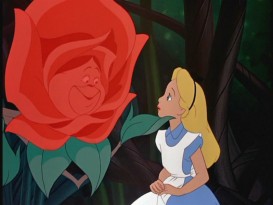Alice in Wonderland: 60th Anniversary Edition Blu-ray + DVD Review
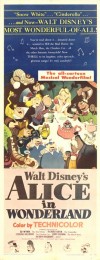 |
Alice in Wonderland
Theatrical Release: July 28, 1951 / Running Time: 75 Minutes / Rating: G Directors: Clyde Geronimi, Wilfred Jackson, Hamilton Luske / Writers: Winston Hibler, Ted Sears, Bill Peet, Erdman Penner, Joe Rinaldi, Milt Banta, William Cottrell, Dick Kelsey, Joe Grant, Dick Huemer, Del Connell, Tom Oreb, John Walbridge (story); Lewis Carroll (novels) Voice Cast: Kathryn Beaumont (Alice), Ed Wynn (Mad Hatter), Richard Hayden (Caterpillar), Sterling Holloway (Cheshire Cat), Jerry Colonna (March Hare), Verna Felton (Queen of Hearts), Pat O'Malley (Tweedledee, Tweedledum, The Walrus, The Carpenter), Bill Thompson (White Rabbit, Dodo), Heather Angel (Alice's Sister), Joseph Kearns (Doorknob), Larry Grey (Bill), Queenie Leonard (Bird in the Tree), Dink Trout (King of Hearts), Doris Lloyd (The Rose), James MacDonald (Dormouse), The Mellomen (Cards) Songs: "Alice in Wonderland", "In a World of My Own", "I'm Late", "The Sailor's Hornpipe", "The Caucus Race", "How D'Ye Do and Shake Hands", "The Walrus and the Carpenter", "Old Father William", "We'll Smoke the Blighter Out", "All in the Golden Afternoon", "A-E-I-O-U (The Caterpillar Song)", "'Twas Brillig", "The Unbirthday Song", "Very Good Advice", "Painting the Roses Red" |
Buy Disney's Alice in Wonderland (1951) from Amazon.com:
There are many popular works of fiction considered unfilmable by their devoted fans. Lewis Carroll's surreal nonsensical tales of Alice's Adventures in Wonderland and Through the Looking Glass have fallen into that category due to their internal logic, constant wordplay, and bizarre episodic structure. Walt Disney was obviously drawn to these stories. The Alice Comedies, related to Carroll's texts in the girl protagonist's name and that a world of anthropomorphic animals surrounded her, were his first successes in animation. Alice in Wonderland was meant to be his first full-length film, inserting actress Mary Pickford into an animated world similar to his earlier short series. Paramount's much-publicized all-star version in 1933 put an end to that Pickford plan, but that didn't stop Disney from returning to the source material. The Mickey Mouse short Thru the Mirror combined elements of both Wonderland and Looking Glass to form a charming new experience. Disney was encouraged to make a full-length animated feature based directly off Carroll's works, and after seemingly endless drafts and approaches, his Alice in Wonderland became a reality in 1951.
The story follows the titular heroine (voiced by Kathryn Beaumont) on a hot summer day as she listens to her sister (Heather Angel) give a history lecture. Her inherent boredom is suddenly interrupted by the appearance of a white rabbit (Bill Thompson) who not only speaks, but wears a waistcoat and carries a pocket watch. Intrigued, Alice follows him down his rabbit hole and falls into the madcap world of Wonderland. Here, she meets a wide variety of odd characters. Among them are squabbling twin brothers Tweedledee and Tweedledum (Pat O'Malley), a haughty caterpillar (Richard Haydn), a mischievous Cheshire Cat (Sterling Holloway) who can disappear at will, and the nutty Mad Hatter (Ed Wynn), March Hare (Jerry Colonna), and Dormouse (James MacDonald) all celebrating their unbirthdays. Throughout these episodes, Alice's size keeps changing by means of the food and drink provided to her. Eventually she finds herself in the company of the boisterous Queen of Hearts (Verna Felton), a tyrant with an affinity for decapitations. Alice tries her best to make it home while still maintaining both her size and her head.
Readers of this site may be familiar with my standard approach to reviewing. I do my best to distance myself from my own expectations and baggage, trying to see what the filmmakers in question have intended and how they've executed those goals. However, film is art, and true art is relative. Critics are audience members, too, and their opinions are no more definitive statements of fact than those of a child who's seen the same picture. There are times when a story is so deeply personal that to take an aloof approach would simply not do it justice. Such is the case with me and Alice in Wonderland.
Until Tim Burton came along, at least, it was Disney's original version of the tale that the general public was most familiar with, and it introduced many, myself included, to this zany world of whimsy. Based on my own experiences with the tales, I can come up with several theories why filmmakers keep returning to them. What most appeals to me is how purely fantastical they are. The fantasy genre is filled with stories that work hard to set a foundation and establish their own set of rules. At their heart, they possess fundamental truths about the human condition and are often careful to point out that life isn't much easier or grander due to magical elements. The Alice stories don't even come close to fitting that mold. They regularly contradict themselves, and just when the audience thinks they've figured out how things work, the stories take a sharp turn into randomness and unpredictability. It's almost liberating to have a free-for-all fantasy world that isn't bound to the constraints of reality.
Of all the adaptations that have tried to capture that essence, Disney's animated version has come the closest. Purists have balked at the film, claiming it destroyed Carroll's work and made it too sugary and mainstream. While I admit that many subconscious layers and inside jokes from the novels get lost in translation, this adaptation is hardly saccharine or sanitized. On the contrary, the criticisms regularly thrown at it are that it's too cold and too strange. It's easy not to be envious of the task Walt Disney had before him. He had to both create something new audiences could relate to while at the same time appease book loyalists. I feel that, for the most part, he succeeded on both accounts.
The Disney film was what made me want to read Carroll's original novels to begin with. Seeing a world so fully removed from reality fascinated me and stimulated my imagination. It dared me to not feel complacent with my surroundings or take everything at face value, instead encouraging me to dream of what could be. Any film that can inspire such feelings from someone previously unfamiliar with the source material has obviously done something right. Having since read both Alice books numerous times throughout the years and returned to Disney's interpretation often, I still find myself impressed with how much of the film works. This picture contains some of the most memorable cast of characters in the Disney canon. They're all true to their Carrollian essence, but the voice actors and animators make sure that these are personas that can exist independently of the source material. It's become a common practice to hire well-known celebrities as voice actors in animated films. Thanks to the 60 years that have passed by since its release, it's easy to forget that Alice in Wonderland may just have been the first time this was put into practice. Most of the voice actors were popular with the general public either from radio, television, or theatre. Unlike most modern cartoons, though, all of these performers fit their roles so perfectly that one doesn't think of the actor.
The three standout examples are Sterling Holloway's Cheshire Cat, Ed Wynn's Mad Hatter, and Jerry Colonna's March Hare. Each gives his character a different sense of madness that can be either hilarious or unsettling. The Cheshire Cat is deceptively suave and approachable, but his vanishing act mingled with his incessant mind games make him a bit eerie. The Mad Hatter and the March Hare complement each other in that they offer more apparent forms of insanity, albeit in different ways. The Hatter is more optimistic and silly whereas the Hare is more cynical and abrasive. Color choices (cool colors for the Hatter, warm for the Hare) also serve to contrast the two while suiting their characteristics. Placed back to back, the Cheshire Cat scene and the mad tea party are two of the film's most memorable sequences, and supervising animator Ward Kimball infuses them with striking mannerisms and a great deal of liveliness.
Alice in Wonderland boasts more songs than any other Disney animated feature. This is understandably overlooked since most of its fourteen numbers run less than 30 seconds (such as the famous "I'm Late"). That sounds bizarre, but it works. The songs are used as a means of sensory experience. Without a strong narrative, the movie needed to heavily push three elements: characters, visuals, and music. The lattermost neither drives the story forward nor screeches it to a halt. Instead, it's so embedded in the dialogue that it can only be classified as the part of the main event rather than some sort of side tool or driving force. Some of these, such as "'Twas Brillig" and "Old Father William", have a basis in Carroll poetry, but most do not. The ones that don't still manage to fit in. They're fun and fanciful, and certain tunes like "The Unbirthday Song" and "Painting the Roses Red" are hard to shake off. The main "Alice in Wonderland" theme acts a thread that links all these episodes together. While it's only sung at the beginning and end of the film, it's implemented into the score on a regular basis and helps underline Alice's sense of awe amidst the nuttier pieces.
One can't discuss the film without acknowledging its arresting imagery. Much of the production's design can be credited to stylist Mary Blair. Because the original John Tenniel illustrations focused on characters, cinematic interpretations of the books have often found themselves in a bit of rut. They adhere very closely to the character designs but struggle with the environments due to Tenniel's minimalist approach to them. That should liberate filmmakers to envision this universe however they wish, without being bound by either preconceived notions or nature's laws. Few adaptations have dared to take advantage of that freedom, though. Disney's happens to be one of them.
Blair's concept art had a more direct effect on the final product than usual. In fact, many of the backgrounds are almost identical to what she initially conceived. What makes this world so alluring is how hard it tries not to be realistic. Everything has a skewed, off-kilter look. The staging is remarkable. At times, Alice feels very theatrical, and that's skillfully tied to the dream motif. As with a stage performance, there's often a sort of spotlight on the characters, and everything else in the background dissolves. When Alice is making her way through the Queen of Hearts' vast hedge maze, only the elements closest to her are fully realized - green shrubs with discernable foliage. Further into the distance, however, we see the maze and sky are gray with only the simplest of definition. In fact, throughout the course of Alice's adventures, only once do we see a fully realized blue sky with white clouds. All other times, the sky is a blotchy void that merely gives off the idea of stars or clouds. It suggests that in Alice's dreams, only what's immediately present to her is clear, and everything else fades into abstraction.
Disney's Alice has been rightfully deemed a technical marvel, but it's also been criticized for its episodic nature. The lack of a cohesive narrative, something that stems from Carroll's books, is both a blessing and a curse. On the plus side, none of the characters overstay their welcome, and Alice is always whisked away to another mini-adventure before the audience can become restless. On the down side, the lack of any goal bigger than catching the rabbit and getting home means that the audience has nothing huge to invest in. We, like Alice, can stand back in awe at the fantasy and laugh at the antics, but there's never a sense that we're heading anywhere or that we even care for Alice's well-being. This becomes particularly troubling during the Tulgey Wood scene.
At this point, Alice finds herself deep in Wonderland and begins to worry about getting home. Rather than having a couple of standout characters like the previous segments, this one throws many zany and whimsical but mute creatures Alice's way. Because of this, the scene drags, especially coming so late in the film. The song "Very Good Advice", in which Alice laments her choices, feels decidedly tacked on. A better approach would've been to spread the vignettes throughout, linking the larger episodes together. Alice's last-minute concern over going home could've been introduced early on and combined with her goal of catching the White Rabbit. As it stands, that goal doesn't make a great deal of sense once she's in Wonderland. Why is she so concerned over finding the rabbit when everything around her is several times more strange and vying for her attention? By having her seek directions home from the White Rabbit and slowly increasing her anxiety, the connective tissue would have been that much more resonant with the audience.
Even as someone who can clearly see some of the creakier narrative troubles, I find little to complain about here. I have never and will never demand textual fidelity in cinematic adaptations. As long as a film can capture the core essence of its source and work on its own, plot and dialogue can be updated. If we're going to focus on literal faithfulness, we should keep in mind that for a Disney adaptation, As a film, 1951's Alice in Wonderland stands as a triumph in artistry. The colorful, surreal animation is pure eye candy far ahead of its time. The songs are chipper, memorable, and have an interesting way of blending with dialogue unlike other movie musicals. The voice acting is among the best ever heard in an animated film. I can sit back and acknowledge that this may not be everyone's cup of tea, but that may be for the better. Sometimes in trying to please everyone, a motion picture can end up pleasing no one. If you're like me and enjoy high-end, whimsical fantasy and witty humor, then I have absolutely no reservations in recommending this brilliant exercise of the imagination.
Placed in the middle class of Disney's animated canon (not nearly as revered as Snow White and the Seven Dwarfs but more marketable than The Sword in the Stone), Alice has an interesting history on home video. The studio has had no problem treating it as a guinea pig, for its reputation wouldn't be tarnished by a collection it's part of it flopping yet it's still iconic enough to attract evergreen interest.
Alice became one of Disney's first titles ever released on Betamax, VHS, and laserdisc, where it debuted in 1981 and 1982. It was released again in all three formats in 1986 with "Classics" ("Black Diamond Classics" to fans) designation. In 1994, it was one of ten comprising a new line, The Walt Disney Masterpiece Collection. A year later, there was a deluxe laserdisc as part of Disney's Archive Collection. A second Masterpiece Collection came in 1999. In 2000, Alice made its DVD debut as part of Disney's voluminous but short-lived Gold Classics Collection, with a handful of extras.
In 2004, the movie seemed to launch a new line with its 2-disc set billed "The Masterpiece Edition." The other titles intended for this series were delayed and eventually released with different branding. But Alice at least got a dramatic new restoration, most of the bonus features included on its 1995 laserdisc, plus a few new treats. Last spring, to capitalize on the $1 billion-grossing Tim Burton 3D extravaganza of the same name, Disney's Special Un-Anniversary Edition essentially repackaged the animated version's discontinued Masterpiece set, adding a new featurette and deleted scene. That DVD remains in print and now just ten months later, basically the first of its two discs joins the movie's first ever Blu-ray Disc in this 60th Anniversary Edition Blu-ray + DVD combo. VIDEO and AUDIO
Alice in Wonderland's original 1.33:1 aspect ratio is preserved within the Blu-ray's 16:9 frame. This is my fourth edition of the movie I'm reviewing here, and I've been satisfied by the transfer on each (yes, even the now dark and fuzzy Gold Collection disc was enough for me back in 2000). It's only when something new comes along that I look back and notice what the previous version was lacking. I didn't think the 2004 restoration could be much improved upon other than a few minor tweaks here and there. Alice is easily one of the most colorful films in the Disney canon, so its color timing is very important. To call the variety on display here eye candy is an understatement. This is a very saturated palette, more than in any other transfer. The 2000 DVD's colors were too dark while the 2004 and 2010 ones were too light. The 2011 Blu-ray's hues achieve brightness without sacrificing boldness. Reds and yellows particularly stand out. Alice's hair is a striking yellow while the red portions of the Queen's dress are a deep cherry. Skin tones are also more pleasing. Alice's skin is no longer ashy, and the Hatter's is no longer pink. There undoubtedly will be those who find the bolder, more vivid colors a problem, deeming them too cartoony. While I honestly can't speak about how this film looked in 1951, I will say that I find the new palette's a better representation of Wonderland than any previous version. That, mixed with a perfectly clean and razor-sharp image, makes for what is one of the best restorations to come from Disney, acting as a hallmark for how traditional animation of any era can look in high-definition.
Unfortunately, this new master has not been utilized for the included bonus DVD. That disc is an almost exact replica of the Un-Anniversary Edition's first disc. That means we get the 2004 restoration included. That transfer is very strong on its own terms, but revisiting it after seeing the new HD master does reveal some problems. While colorful, the scheme doesn't pop as much as it could. Most hues are too pale while a few rare ones are slightly drab. The image is also less stable, with the slightest bit of flickering and grain evident on the backgrounds. Compression is kept low, and sharpness is reasonable. The transfer holds up pretty well, but it's a shame the new one wasn't used here. The Blu-ray's DTS-HD 5.1 track isn't an aggressive mix, nor should it be. You're dealing with a monaural source, after all, the original of which is also included. Still, the film has never sounded better. There's a breadth and clarity here that unearths all sorts of once-hidden layers. As with the image, I found myself discovering new elements of a soundtrack I thought I knew intimately. The biggest example of this is when the White Rabbit's watch goes mad during the tea party. On the DVDs, everyone is screaming over each other in a panic, the March Hare being the most dominant one. On this new mix, that remains so, but you can actually hear the other characters in the background quite clearly. All of the track's dialogue, in fact, is very intelligible and crisp. Music also feels more prominent here than before and is given more scope. Effects occasionally are thrown at the rears, but the score is really what utilizes the surround channels the most. The sound designers haven't gone crazy with the new mix, which is a good thing. The elements have more delineation than before without betraying the source.
The bonus DVD's Dolby Digital 5.1 track once again replicates what was found on the previous release. The results are quite good despite feeling like broad mono. There's less separation than on the Blu-ray; the DVD is more front heavy and when it expands for things like the score, it all seems to come out everywhere at once. Dialogue is very clear considering the source's age, though sound effects can be a tad dull. Still, it's hard to find any real fault with this solid track.
Continue to Page 2 >>
Support great cinema and this site -- Buy Alice in Wonderland from Amazon.com:
60th Anniversary Edition Blu-ray + DVD • 2-Disc Un-Anniversary Edition DVD • 2-Disc Masterpiece Edition DVD • Gold Collection DVD
By Kelvin Cedeno
Yet, this hasn't stopped filmmakers from dipping into the treacle well and adapting these classic works. What is it about the novels that keeps directors and screenwriters coming back to them in the face of unworkable elements? Why has film been treated to at least one retelling of these stories every decade (and often more)?
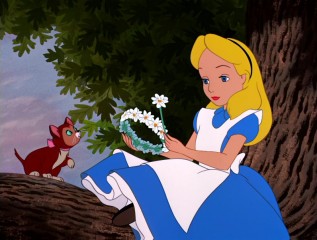
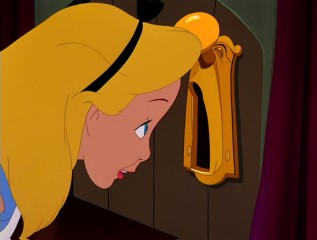

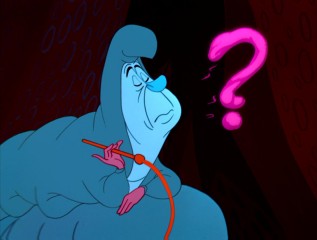
Most filmmakers are so afraid of tampering with a classic that they focus too much on the literal side of adapting and often lose sight of the characterizations and tone. Disney follows the events well enough to be recognizable, but isn't afraid to modify portions to suit the film medium and put its own stamp on things.
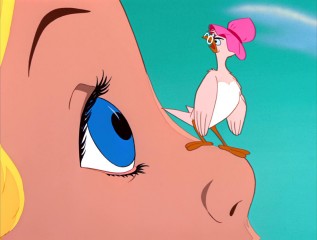


Alice features more of its source's dialogue and plot mechanics than perhaps any other of the studio's movies, save for The Many Adventures of Winnie the Pooh.
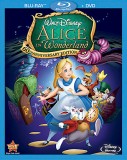
Blu-ray & DVD Details
1.33:1 Original Aspect Ratio (Fullscreen)
BD: DTS-HD MA 5.1 (English), Dolby Digital 5.1 DEHT Mix (French, Spanish)
DVD: Dolby Digital 5.1 (English, French, Spanish)
Both: Dolby Mono 2.0 (English)
Subtitles: English for Hearing Impaired, French, Spanish
Closed Captioned; Extras Subtitled
Release Date: February 1, 2011
Two single-sided, dual-layered discs (1 BD-50 & 1 DVD-9)
Suggested Retail Price: $39.99
Blue Keepcase in Embossed Holographic Cardboard Slipcover
Still available 2-Disc Special Un-Anniversary Edition DVD ($29.99 SRP)
Previously Released as 2-Disc Masterpiece Edition DVD and Gold Collection DVD
I was wrong. This new 2011 presentation is staggering in every regard. As with other Disney Blu-rays like Fantasia and Sleeping Beauty, Alice is a revelation. I've seen this movie more times than I'd probably care to admit, and I was able to notice details that never leapt out at me before. Things like the knick knacks down the rabbit hole, the sparkles that adorn Alice's unbirthday cake, and the bases of the Queen's hedges peeking out from under the shrubbery have always been there, but the increased detail and clarity makes them apparent to me for the first time. We also gain slightly more picture on all four sides, most noticeably on the left and the bottom. The image is so refined that certain multi-plane shots almost look 3D, and you can see everything from cel shadows to background brushstrokes. Even the separation between background and animated elements is clearly delineated (such as the Dormouse's teapot lid or the foreground daisies Alice wades through).
60th Anniversary Edition Blu-ray + DVD Combo / 2-Disc Un-Anniversary Edition DVD

Related Countdowns:
DVDizzy.com | Disney Animated Classics | DVD & Blu-ray Reviews | Schedule | Disney Schedule | Disney Blu-ray | Upcoming Cover Art | Search
DVDizzy.com Top Stories:
Related Reviews:
Alice in Wonderland (2010) (Blu-ray + DVD Combo) • Walt Disney Treasures: Disney Rarities (featuring the Alice comedies) • Alice (2009)
Disney Blu-ray Combos: Beauty and the Beast • Fantasia & Fantasia 2000 • Snow White and the Seven Dwarfs • Secretariat
1950s Disney Animation: Peter Pan • Cinderella • Lady and the Tramp • Sleeping Beauty
Waking Sleeping Beauty • The Boys: The Sherman Brothers' Story • Walt & El Grupo • Return to Oz • Spirited Away • Coraline • Kiki's Delivery Service
Walt Disney Animation Collection: Mickey and the Beanstalk • Mickey Mouse Clubhouse: Mickey's Adventures in Wonderland
The Many Adventures of Winnie the Pooh • The Adventures of Ichabod and Mr. Toad • Robin Hood

Our Interview with Kathryn Beaumont (the voice and model for Alice and Peter Pan's Wendy)
Top 100 Disney Songs Countdown (featuring three Alice in Wonderland songs)
Top 30 Disney Villains Countdown (featuring The Queen of Hearts) | Top 50 Disney Heroes & Heroines Countdown (featuring Alice)

